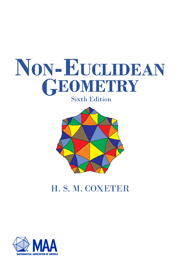Book contents
- Frontmatter
- PREFACE TO THE SIXTH EDITION
- Contents
- I THE HISTORICAL DEVELOPMENT OF NON-EUCLIDEAN GEOMETRY
- II REAL PROJECTIVE GEOMETRY: FOUNDATIONS
- III REAL PROJECTIVE GEOMETRY: POLARITIES, CONICS AND QUADRICS
- IV HOMOGENEOUS COORDINATES
- V ELLIPTIC GEOMETRY IN ONE DIMENSION
- VI ELLIPTIC GEOMETRY IN TWO DIMENSIONS
- VII ELLIPTIC GEOMETRY IN THREE DIMENSIONS
- VIII DESCRIPTIVE GEOMETRY
- IX EUCLIDEAN AND HYPERBOLIC GEOMETRY
- X HYPERBOLIC GEOMETRY IN TWO DIMENSIONS
- XI CIRCLES AND TRIANGLES
- XII THE USE OF A GENERAL TRIANGLE OF REFERENCE
- XIII AREA
- XIV EUCLIDEAN MODELS
- XV CONCLUDING REMARKS
- APPENDIX: ANGLES AND ARCS IN THE HYPERBOLIC PLANE
- BIBLIOGRAPHY
- INDEX
XIV - EUCLIDEAN MODELS
- Frontmatter
- PREFACE TO THE SIXTH EDITION
- Contents
- I THE HISTORICAL DEVELOPMENT OF NON-EUCLIDEAN GEOMETRY
- II REAL PROJECTIVE GEOMETRY: FOUNDATIONS
- III REAL PROJECTIVE GEOMETRY: POLARITIES, CONICS AND QUADRICS
- IV HOMOGENEOUS COORDINATES
- V ELLIPTIC GEOMETRY IN ONE DIMENSION
- VI ELLIPTIC GEOMETRY IN TWO DIMENSIONS
- VII ELLIPTIC GEOMETRY IN THREE DIMENSIONS
- VIII DESCRIPTIVE GEOMETRY
- IX EUCLIDEAN AND HYPERBOLIC GEOMETRY
- X HYPERBOLIC GEOMETRY IN TWO DIMENSIONS
- XI CIRCLES AND TRIANGLES
- XII THE USE OF A GENERAL TRIANGLE OF REFERENCE
- XIII AREA
- XIV EUCLIDEAN MODELS
- XV CONCLUDING REMARKS
- APPENDIX: ANGLES AND ARCS IN THE HYPERBOLIC PLANE
- BIBLIOGRAPHY
- INDEX
Summary
The meaning of “elliptic” and “hyperbolic.” In ordinary Euclidean geometry, a central conic may be either an ellipse or a hyperbola. For any central conic, the pairs of conjugate diameters belong to an involution (of lines through the centre); but it is only the hyperbola that has self-conjugate diameters (viz. its two asymptotes). Accordingly, any involution (and so, conveniently, any one-dimensional projectivity) is said to be hyperbolic if it has two self-corresponding elements, and elliptic if it has none. Analogously, a polarity is said to be hyperbolic or elliptic according as it does or does not contain self-conjugate elements. Finally, a non-Euclidean geometry is said to be hyperbolic or elliptic according to the nature of its absolute polarity.
A more direct connection with ellipses and hyperbolas will be seen in Fig. 14.2A.
Beltrami's model. In the case of two-dimensional hyperbolic geometry, we are at liberty to draw the Absolute as a circle in the Euclidean plane, provided we understand that we are then using two metrics simultaneously: the Euclidean metric by which the circle is drawn, and the hyperbolic metric defined by 10.71 and 10.73. The poles and polars are taken with respect to the circle in the ordinary sense, as the constructions involved are essentially projective. This model for hyperbolic geometry is due to Beltrami (1835-1900).
- Type
- Chapter
- Information
- Non-Euclidean Geometry , pp. 252 - 266Publisher: Mathematical Association of AmericaPrint publication year: 1998

